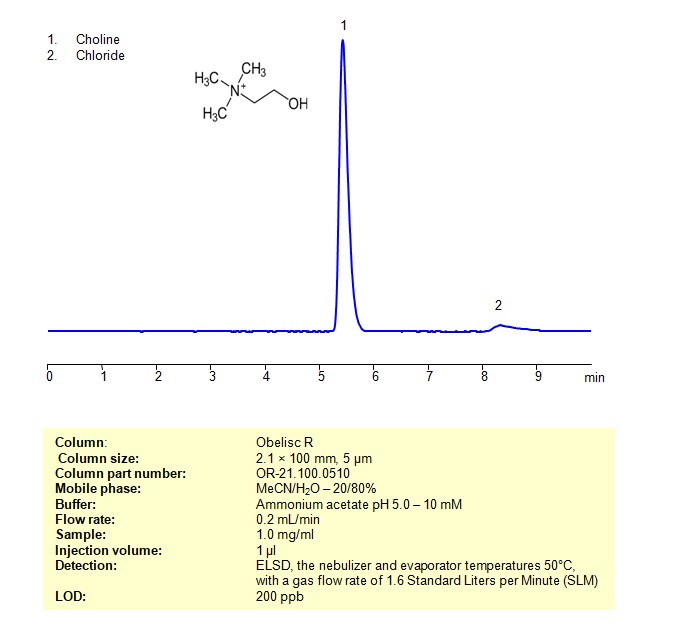HPLC Method for Analysis of Choline on Obelisc R by SIELC Technologies
High Performance Liquid Chromatography (HPLC) Method for Analysis of Choline
Choline is an essential nutrient that plays a crucial role in various physiological processes in the body. It is often grouped with B-vitamins, but it is not officially recognized as a vitamin. Choline serves several important functions, including:
- Cell Membrane Structure: Choline is a component of phospholipids, essential structural components of cell membranes. It helps maintain the structural integrity and fluidity of cell membranes.
- Neurotransmitter Synthesis: Choline is a precursor to acetylcholine, a neurotransmitter that is involved in muscle control, memory, and other cognitive functions. Adequate choline levels are important for maintaining proper neurotransmitter balance in the brain.
- Methyl Group Donor: Choline is a source of methyl groups, which are important for various biochemical reactions in the body, including the methylation of DNA, a process that regulates gene expression.
- Brain Development: Choline is particularly important during periods of rapid growth, such as fetal development and early childhood. Adequate choline intake during pregnancy is associated with better cognitive outcomes in children.
- Liver Function: Choline is involved in lipid metabolism and helps prevent the accumulation of fat in the liver. It is essential for the transport and metabolism of fats, and it plays a role in preventing non-alcoholic fatty liver disease.
- Muscle Function: Choline is involved in muscle movement and helps regulate the functioning of muscles.
Food Sources:
Choline is found in a variety of foods. Some good dietary sources of choline include:
- Eggs
- Meat, poultry, and fish
- Dairy products
- Nuts and seeds
- Certain vegetables, such as broccoli and Brussels sprouts
Choline can be retained and analyzed using an Obelisc R mixed-mode stationary phase column. The analysis employs an isocratic method with a simple mobile phase consisting of water, acetonitrile (MeCN), and ammonium acetate as a buffer. Detection is achieved using ELSD
| Column | Obelisc R, 2.1 x 100 mm, 5 µm, 100 A, dual ended |
| Mobile Phase | MeCN/H2O – 20/80% |
| Buffer | Ammonium acetate pH 5.0 – 10 mM |
| Flow Rate | 0.2 ml/min |
| Detection | ELSD, the nebulizer and evaporator temperatures 70°C, with a gas flow rate of 1.6 Standard Liters per Minute (SLM) |
| Samples | 1 mg/ml |
| Injection volume | 1 µl |
| LOD* | 200 ppb |
| Class of Compounds | Quaternity amines |
| Analyzing Compounds | Choline |
Application Column
Obelisc R
Column Diameter: 2.1 mm
Column Length: 100 mm
Particle Size: 5 µm
Pore Size: 100 A
Column options: dual ended






